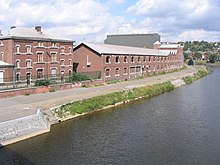Vieille Montagne

Vieille Montagne is the name of a former zinc mine in Kelmis (La Calamine), a town in Belgium between Liège and Aachen. The mine's name is French for "the old mountain", and this is also reflected in its German name, Altenberg (earlier, Alten Galmei-Berg).[1] The mine was once a bone of contention between Prussia on the one side and the United Kingdom of the Netherlands (later Belgium) on the other, that resulted in a piece of land that became the territory of Neutral Moresnet.
The mine was first opened in 1805 and continued its operation until the end of the nineteenth century, when a workforce of 300 produced 8,500 t of crude zinc annually.[2]
The company opened a second zinc mine in Zinkgruvan in Sweden, which is still in operation. It also ran a harbour in Åmmeberg to ship the zinc. The ore was shipped to another affiliate in Balen, Belgium.
The company also had mines in the UK in Nenthead, a village in Cumbria, which were worked from 1896 until 1949. In the department of Ariège in France the VM company took the lease on the zinc mines at Bentaillou in the Pyrenees, also after World War II.
The name became synonymous with zinc oxide[3] and with rolled zinc, especially for building applications. The company was the world's oldest and also largest zinc producer, producing at its peak at least 149,000 tonnes per year.[4] In 1989 Vieille Montagne was merged into the Union Minière group, based in Belgium, which became Umicore in 2003. The group continues its rolled zinc activity under the brand VMZinc which still refers back to the historical link with Vieille Montagne.
Strike in Balen
This article may be a rough translation from Dutch. It may have been generated, in whole or in part, by a computer or by a translator without dual proficiency. |
In 1971 it was discovered the workmen in the other Belgian plants had a much higher salary for similar work. The workers in Balen wanted a raise. This led to a dispute between the workmen, the trade unions and the directors board. The 1500 workmen in Balen went on strike, but this was not accepted by the trade unions. As a result, the workmen were not paid. The strike went on for 9 weeks. Many charities were set up by inhabitants of Mol and Balen. Jef Sleeckx, a politician, convinced the banks to cancel payments temporarily for affected workmen. Houselords did not ask rent during the strike. All kind of shops gave food for free or gave the impacted workmen a temporary job. At the end, the directors board agreed and the workmen even got a higher loan than requested. The events in Balen were written in the theatre play and novel "Groenten uit Balen" by Walter van den Broeck. The book was filmed in 2012. All events regarding the strike did happen, all referenced places do/did exist, and only the family Debreucker is a fictive one.[5]
See also
References
- ^ Hoch, Charles (1882), The Neutral Territory of Moresnet, trans. William Warren Tucker, p 6
- ^ Brockhaus' Konversations-Lexikon. Fourteenth edition, Leipzig, Berlin and Vienna 1894; Volume 3, page 300.
- ^ Chemical & metallurgical engineering: Volume 27
- ^ Engineering and mining journal: Volume 139
- ^ Walter Van den Broeck’s Groenten uit Balen catapults us 40 years back in time
